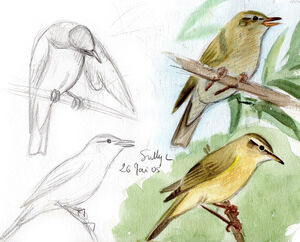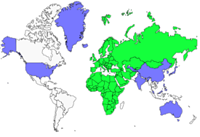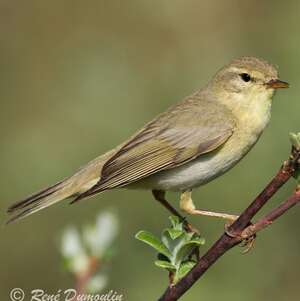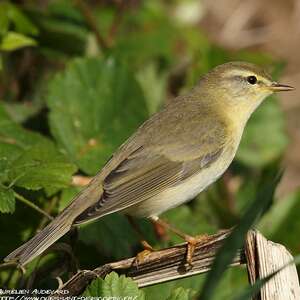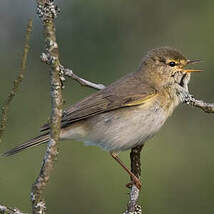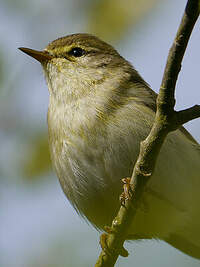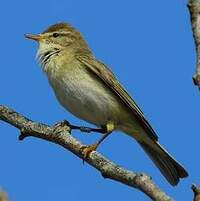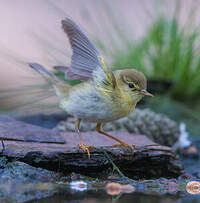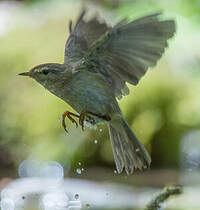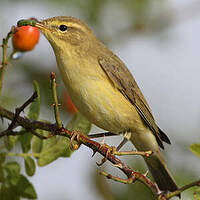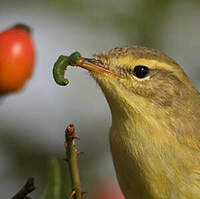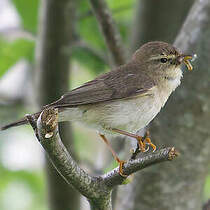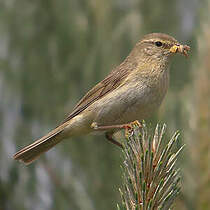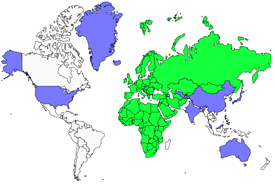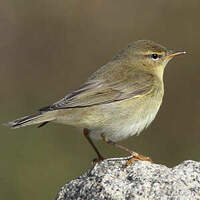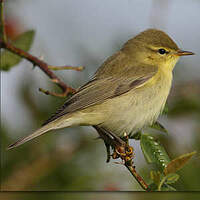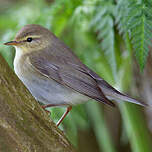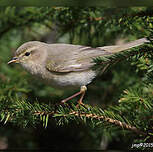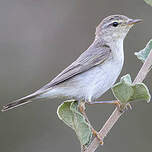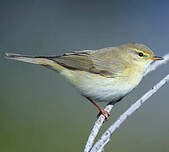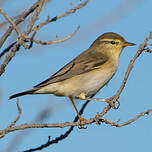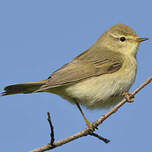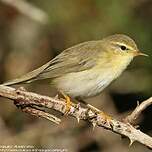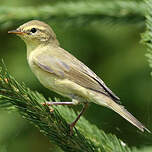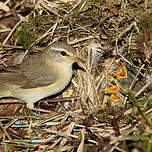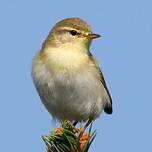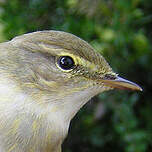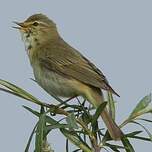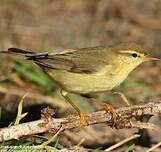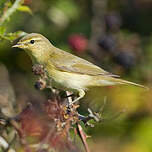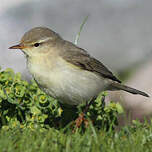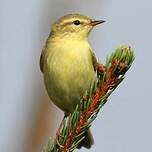Willow Warbler
Phylloscopus trochilus - Pouillot fitis
Identification
The Willow Warbler is a bird slightly larger than the Chiffchaff, but more slender and paler. The upper parts are a pale brown tinged with olive. The wings and tail are darker, but the light fringes of the feathers are of the same colour as the coverts. The underparts are white, tinted with yellow to yellow-olive mainly on the chest and flanks.
Now let's take a look at the specific identification criteria of the adult of the nominate subspecies of Middle Europe (vs the Chiffchaff):
- Primary projection: The Willo Warbler has the long wing of a long-distance migrant. The tips of the primaries protrude significantly more from the tertiaries than in the Chiffchaff.
- Leg colour: It is quite variable, yellowish, reddish, pale brown, with the foot of a more marked hue, but never dark brown to blackish like the Chiffchaff.
- The head: A clear and long pale yellow eyebrow, sometimes yellow in front and white behind, outlines the eye. Its sharpness makes the pale orbital ring less visible than in the Chiffchaff. The beak is long and tinged with yellow along the commissure (fine and dark in the Chiffchaff). Finally, the ear coverts are beige (brown in the Chiffchaff).
The juvenile is characterised by a much yellower plumage which makes it resemble for example a Subalpine Warbler. The voice and silhouette are different. The Subalpine Warbler often bristles the feathers of the crown and has light lores, while the Willow Warbler has a clear dark loral line.
The adults of the northern European subspecies acredula are paler, more grey-brown on the upper parts, with a more discreet yellow on the head and on the chest.
Finally, the adults of the central and eastern Siberian subspecies yakutensis have a grey-brown upper part without olive (except on the fringes of the remiges) and a white underside, tinted with greyish on the chest.The yellow only occurs on the undersides of the wings and is not visible. The very prominent brow is white.
Subspecific information 3 subspecies
- Phylloscopus trochilus trochilus (s Sweden, w and c Europe)
- Phylloscopus trochilus acredula (Scandinavia. except s Sweden. to e Europe and w Siberia)
- Phylloscopus trochilus yakutensis (c and e Siberia)
Foreign names
- Pouillot fitis,
- Mosquitero musical,
- felosa-musical,
- Fitis,
- fitiszfüzike,
- Fitis,
- Luì grosso,
- lövsångare,
- Løvsanger,
- kolibiarik spevavý,
- budníček větší,
- Løvsanger,
- pajulintu,
- Hofsanger,
- mosquiter de passa,
- Laufsöngvari,
- piecuszek,
- vītītis,
- severni kovaček,
- Пеночка-весничка,
- キタヤナギムシクイ,
- 欧柳莺,
- 歐亞柳鶯,
Voice song and cries
The song of the Willow Warbler is very typical and unmistakable. It is a suite of varied whistled notes, emitted in a descending cascade, the first ones quite short and similar, the following ones fuller and melodic, lasting from 4 to 5 seconds.
The call is a u it, clearly bisyllabic compared to the single uit of the Common Chiffchaff.
Habitat
In the breeding season, the Willow Warbler is not a woodland bird like its cousin the Chiffchaff can be.
In winter, it visits all kinds of wooded environments, particularly the acacia savannah.
Behaviour character trait
The Willow Warbler is a great migrant which spends the boreal winter in Africa, mostly south of the Sahara, including those of the far east Russia birds, which distance to be covered can exceed 12,000 km, or 24,000 km round trip, to be covered in stages of more than 200 km.
That's phenomenal for an 8 gram bird!The Warbler is aptly named Phylloscopus for it spends its time fluttering in the bushes, inspecting the foliage for its prey, even taking a hovering flight for reconnaissance, rarely resting. It rarely goes down to the ground.
Flight
Dietfeeding habits
The Willow Warbler primarily feeds on insects, their eggs and larvae and the prey spectrum is very broad.
It can also extend to other invertebrates such as small mollusks. It hunts in the foliage, the canopy of shrubs, lower down in bad weather and even on the ground when necessary. The young are mainly fed on various larvae and aphids, which are often numerous, can be harvested in large numbers. In summer after reproduction, it turns like the warblers to the small fruits that reach maturity, in particular those of Rubus, wild currants, then of elderberries, elder trees, etc.Reproduction nesting
The breeding period runs from April to July, depending on latitude. In temperate Europe, birds mainly arrive from the beginning of April.
Males stake out and use their song to attract a female. Their territoriality is quite aggressive. Mating coincides with the arrival of the female on the territory and is expressed mainly by the male's gesturing in front of his partner. Nest-building starts without delay; the female is helped by the male in bringing material. The nest is typical of the Willow Warbler, a bowl-shaped nest with a lateral entrance, well hidden on the ground in a tuft of herbs or shrubs, made of dry stems of herbaceous plants, leaves, moss, lined with vegetable hairs, fur and feathers. The laying consists of 4 to 8 white-cream eggs, lightly spotted with sand-brown, especially at the larger end. The female incubates for 12 to 14 days and the young stay in the nest for a further 15 days. The parents stay and care for the young outside the nest for another 15 days. Thus the breeding requires an investment of around two months. Males are often polygamous. Second clutches are rare and by July they disperse after the nuptial period.Geographic range
The breeding range of the Willow Warbler stretches across the full length of the Eurasian continent from the British Isles to the far eastern reaches of Russia. In terms of latitude, it is found throughout the entire European and Russian Arctic regions, southwards to Central Europe. The southern boundary goes through the northern regions of Spain, where it is rare, the south of France, skirting around the Alps to the north, then eastwards along a central latitude up to northern Ukraine, south-western Russia, northern Kazakhstan, and on through the south and south-eastern regions of Russia. However, this wide range is not evenly occupied. The population's centre lies distinctly in the European continent. The winter range is in Africa south of the Sahara to the Cape. A small minority of the population winters on the northern fringes of the Sahara and in Ethiopia.
Threats - protection
IUCN conservation status
concern
in the Wild
threatened
evaluated
The Willow Warbler is a common species, not threatened, although a moderate decline has been reported in Europe since the 1980s. In contrast, it is noted to be expanding towards the north in Russia, possibly as a result of climate warming. The species is affected by the drought conditions prevalent in its wintering grounds and by habitat loss due to human activity in its breeding zones.
Sources of information
- IOC World Bird List (v14.1), Gill, F and D Donsker (Eds). 2024-04-18.
- Les passereaux d'Europe, tome 2, P. Géroudet, M. Cuisin
- Birds of the World, The Cornell Lab of Ornithology
- xeno-canto, Sharing bird sounds from around the world,
Other sources of interest
 Specification sheet created on
21/07/2023 by Jean François
Specification sheet created on
21/07/2023 by Jean FrançoisTranslation by AI Oiseaux.net
published: 23-05-2021 - Updated: 23-05-2021
© 1996-2024 Oiseaux.net
- Accipitriformes
- Aegotheliformes
- Anseriformes
- Apodiformes
- Apterygiformes
- Bucerotiformes
- Caprimulgiformes
- Cariamiformes
- Casuariiformes
- Charadriiformes
- Ciconiiformes
- Coliiformes
- Columbiformes
- Coraciiformes
- Cuculiformes
- Eurypygiformes
- Falconiformes
- Galliformes
- Gaviiformes
- Gruiformes
- Leptosomiformes
- Mesitornithiformes
- Musophagiformes
- Nyctibiiformes
- Opisthocomiformes
- Otidiformes
- Passeriformes
- Pelecaniformes
- Phaethontiformes
- Phoenicopteriformes
- Piciformes
- Podargiformes
- Podicipediformes
- Procellariiformes
- Psittaciformes
- Pterocliformes
- Rheiformes
- Sphenisciformes
- Steatornithiformes
- Strigiformes
- Struthioniformes
- Suliformes
- Tinamiformes
- Trogoniformes

